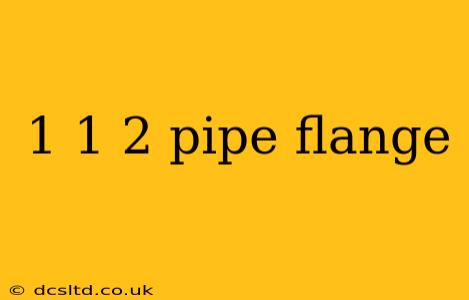Pipe flanges are essential components in piping systems, providing a reliable method for connecting pipes, valves, and other equipment. Understanding the specifics of a particular flange, like the 1 1/2" pipe flange, is crucial for ensuring system integrity and safety. This guide will delve into the details of 1 1/2" pipe flanges, covering their types, applications, and crucial considerations for selection and installation.
What is a 1 1/2" Pipe Flange?
A 1 1/2" pipe flange is a circular metal plate, typically made of steel, cast iron, or stainless steel, with a nominal diameter of 1 1/2 inches. This refers to the inside diameter of the pipe it's designed to connect to, not the flange's overall diameter. The flange features bolt holes around its perimeter, allowing it to be securely bolted to another flange, creating a sealed connection. The specific design and material of the 1 1/2" flange will vary depending on the application and pressure requirements.
What are the Different Types of 1 1/2" Pipe Flanges?
Several types of 1 1/2" pipe flanges cater to various needs and pressure ratings. Common types include:
-
Slip-on Flanges: These flanges slip over the pipe end and are welded to it. They are relatively easy to install but may not be suitable for high-pressure applications.
-
Weld Neck Flanges: Offering superior strength and resistance to high pressure and temperature, weld neck flanges are welded to the pipe neck, creating a smooth, continuous flow path.
-
Blind Flanges: These solid discs are used to close off the end of a pipe. They are essential for maintenance, testing, or isolating sections of the piping system.
-
Socket Weld Flanges: Designed for smaller diameter pipes, socket weld flanges have a recessed area into which the pipe is inserted and welded.
-
Threaded Flanges: These flanges are threaded onto the pipe, offering a simpler installation method than welding, but with lower pressure ratings.
The choice of flange type depends heavily on factors such as the piping system's pressure, temperature, and the type of fluid being transported.
What are the Common Materials Used for 1 1/2" Pipe Flanges?
The material of a 1 1/2" pipe flange significantly impacts its durability, corrosion resistance, and suitability for various applications. Common materials include:
-
Carbon Steel: A cost-effective option suitable for many general applications.
-
Stainless Steel: Offers excellent corrosion resistance, making it ideal for applications involving corrosive fluids.
-
Cast Iron: Provides good strength but may be susceptible to corrosion in certain environments.
-
Ductile Iron: A more durable alternative to cast iron, offering enhanced strength and ductility.
How are 1 1/2" Pipe Flanges Used?
1 1/2" pipe flanges are utilized in a wide range of applications across various industries, including:
-
Oil and Gas: Connecting pipelines and equipment in refineries and processing plants.
-
Chemical Processing: Handling corrosive fluids and chemicals.
-
Water Treatment: Used in water distribution and purification systems.
-
HVAC: Connecting pipes in heating, ventilation, and air conditioning systems.
What are the Safety Considerations When Using 1 1/2" Pipe Flanges?
Safety is paramount when working with pipe flanges. Always ensure:
-
Proper Material Selection: Choose flanges made of materials compatible with the fluid being transported and the operating conditions.
-
Correct Torque: Bolts must be tightened to the manufacturer's specified torque to ensure a leak-proof seal.
-
Regular Inspection: Periodically inspect flanges for signs of corrosion, damage, or leaks.
-
Appropriate Safety Equipment: Wear appropriate personal protective equipment (PPE), including safety glasses and gloves, when working with flanges.
What are the different pressure classes for 1 1/2" pipe flanges?
The pressure class of a 1 1/2" pipe flange indicates its ability to withstand pressure. This is usually denoted by a pressure rating (e.g., 150#, 300#, 600#) which corresponds to the maximum allowable pressure at a given temperature. The pressure class must be carefully selected to ensure the flange can safely handle the operating pressure of the system.
Where can I find more information on 1 1/2" pipe flanges?
For detailed specifications, material properties, and industry standards related to 1 1/2" pipe flanges, refer to resources like ASME (American Society of Mechanical Engineers) standards and manufacturer's catalogs. These resources provide comprehensive technical data essential for proper selection and use. Remember to always consult with qualified professionals for complex piping systems or high-pressure applications.
